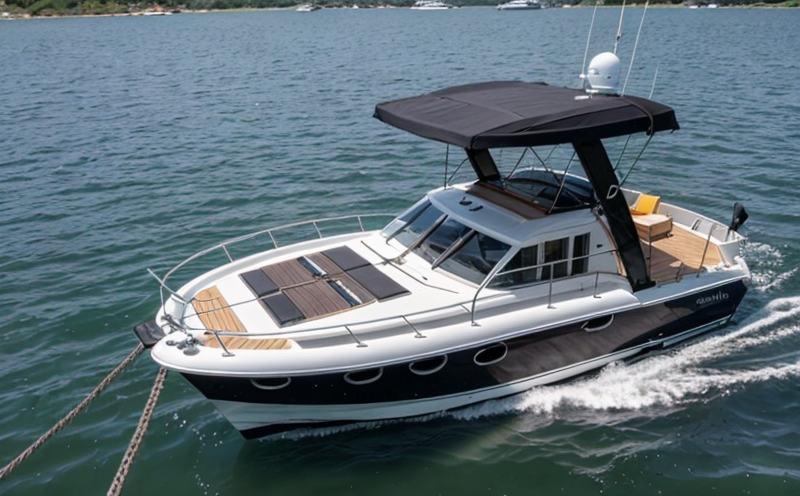ISO 1969 Anchor Holding Power Testing in Soil Beds
The ISO 1969 standard specifies a method for determining the holding power of anchors installed into soil beds. This testing is crucial for ensuring that marine and ship equipment, particularly mooring systems and anchoring devices, can withstand environmental stresses and loads safely and effectively.
Anchor holding power testing in soil beds is primarily used to evaluate the ability of an anchor to resist pullout forces under specified conditions. The test simulates real-world scenarios where anchors are subjected to various loading conditions such as wind, waves, and vessel movement. This service provides critical data for assessing the reliability and performance of mooring systems and anchoring devices in maritime environments.
The testing procedure involves embedding an anchor into a soil bed and applying gradually increasing load until it is pulled out or reaches its maximum rated capacity. The test setup typically includes a load cell to measure the applied force, a displacement sensor to monitor any movement, and a data acquisition system to record the test results accurately.
Specimen preparation for this testing is critical. Soil samples are collected from the intended installation site using standardized procedures as per ISO 18560-3. The soil is then compacted into a container or mold to form a cylindrical soil bed of uniform density and composition, ensuring that the test results are representative of actual conditions.
Instrumentation used in this testing includes high-capacity load cells capable of measuring forces up to several hundred kilonewtons (kN), displacement sensors with sub-millimeter resolution, and data acquisition systems capable of capturing continuous force-displacement curves. The data is analyzed to determine the ultimate holding capacity and any potential points of failure.
The acceptance criteria for this test are based on the anchor’s specified rated capacity. An anchor passes the test if it can resist a pullout force that exceeds 90% of its rated capacity without significant deformation or failure. The test results provide valuable information for selecting appropriate anchors and mooring systems, ensuring compliance with maritime regulations and safety standards.
For quality managers, compliance officers, R&D engineers, and procurement professionals involved in the design and selection of marine equipment, this testing ensures that the equipment meets international standards and performs reliably under various loading conditions. By using ISO 1969 anchor holding power testing in soil beds, stakeholders can make informed decisions that enhance safety, reduce risks, and comply with regulatory requirements.
Industry Applications
ISO 1969 anchor holding power testing in soil beds is widely used across various sectors within the marine and ship equipment industry. This table highlights key applications:
| Sector | Application |
|---|---|
| Marine Construction | Evaluation of mooring systems for offshore platforms. |
| Oceanographic Research | Determining the reliability of anchors in deep-sea environments. |
| Offshore Oil & Gas | Assessing anchor holding power for FPSOs (Floating Production, Storage, and Offloading units). |
| Shipping & Navigation | Evaluating the performance of anchors in various sea states. |
- Marine construction projects require robust mooring systems to secure offshore platforms against harsh environmental conditions.
- Oceanographic research vessels need reliable anchoring solutions for stable positioning during scientific surveys.
- In the offshore oil and gas sector, FPSOs must have anchors that can withstand extreme forces from storms and high seas.
- Shipping companies rely on accurate anchor testing to ensure vessel stability in different sea states, enhancing safety and operational efficiency.
Eurolab Advantages
At Eurolab, we offer comprehensive ISO 1969 anchor holding power testing services tailored to meet the specific needs of our clients. Our advantages include:
- Precision and Accuracy: Utilizing state-of-the-art instrumentation such as high-capacity load cells and displacement sensors.
- Expertise: Skilled technicians with extensive experience in marine equipment testing.
- Compliance: Adherence to international standards, ensuring that test results are reliable and valid for regulatory compliance.
- Customization: Tailored testing protocols to meet specific client requirements.
- Reporting: Detailed reports providing comprehensive analysis of the test data.
We provide a seamless testing process from specimen preparation to final report delivery, ensuring that our clients receive accurate and actionable insights into their marine equipment performance.
Why Choose This Test
Choosing ISO 1969 anchor holding power testing in soil beds offers several benefits:
- Safety Assurance: Ensures that anchors and mooring systems can withstand the forces they will encounter in real-world conditions.
- Regulatory Compliance: Meets international standards, ensuring compliance with maritime regulations and safety requirements.
- Risk Mitigation: Identifies potential weaknesses or failures before deployment, reducing risks during operations.
- Performance Optimization: Provides data for optimizing anchor design and performance parameters.
- Cost Efficiency: Reduces the likelihood of equipment failure in service, minimizing repair costs and downtime.
The test results are invaluable for stakeholders involved in the marine industry, helping to enhance safety, reduce risks, and improve operational efficiency.





